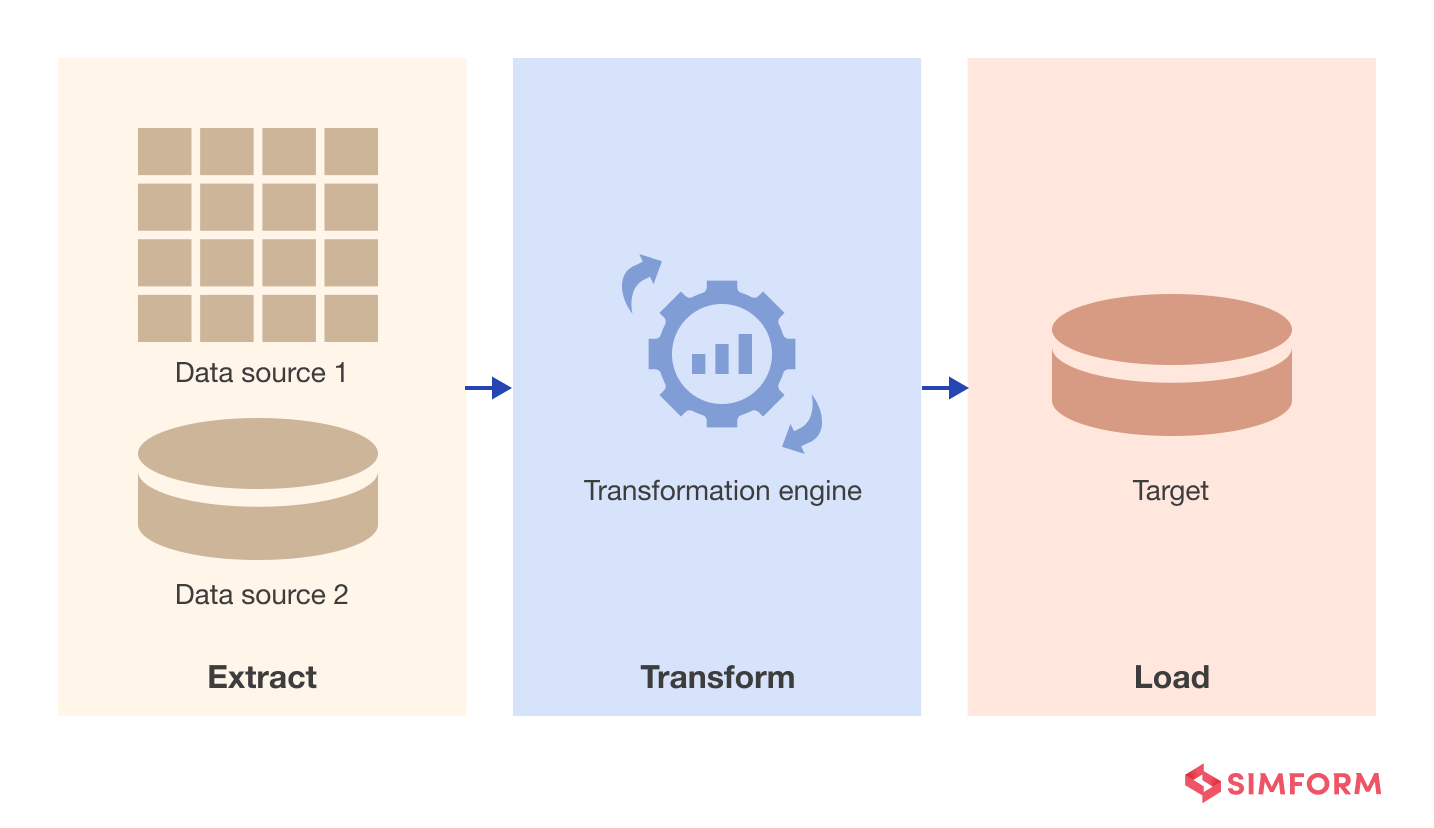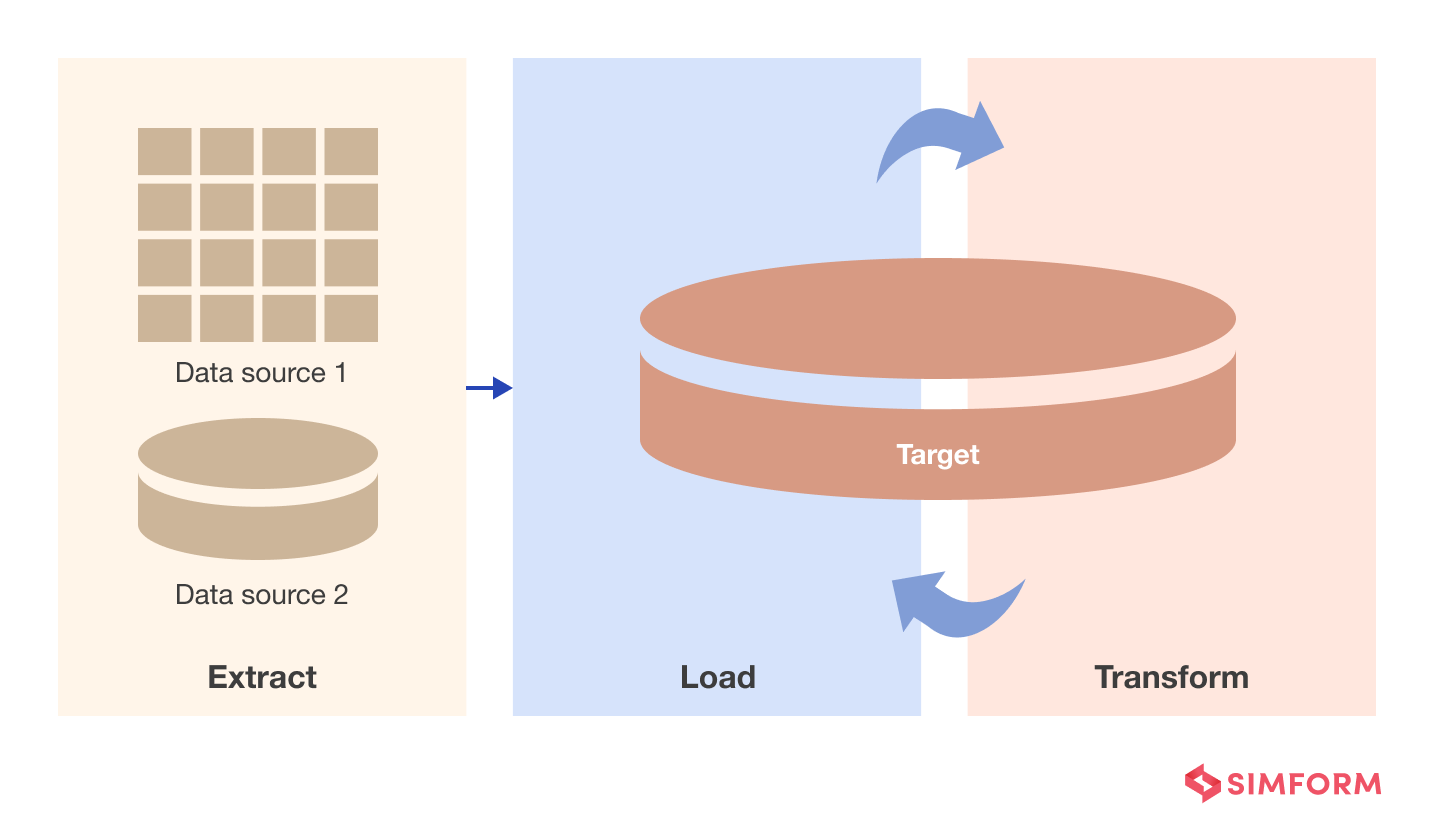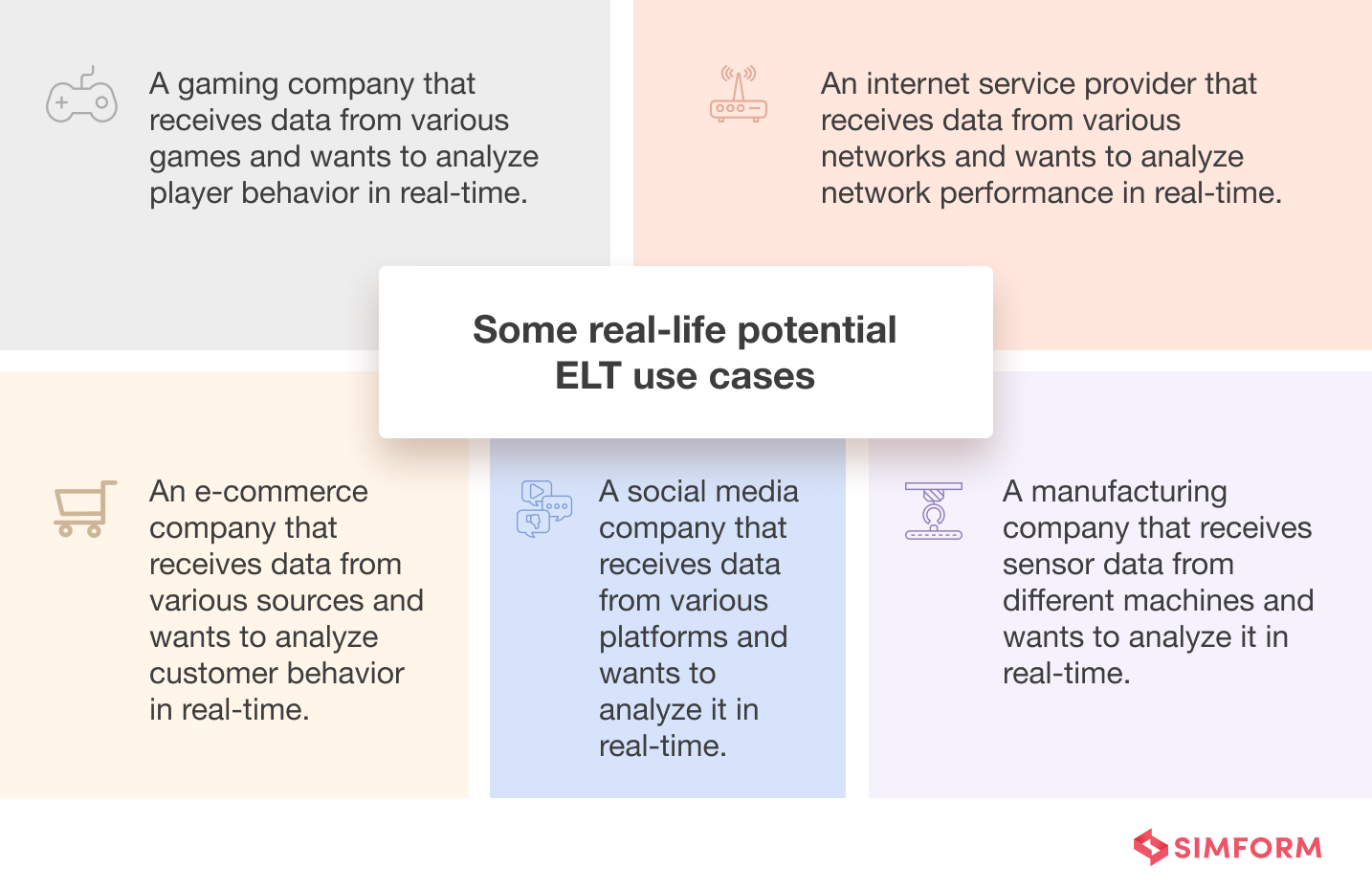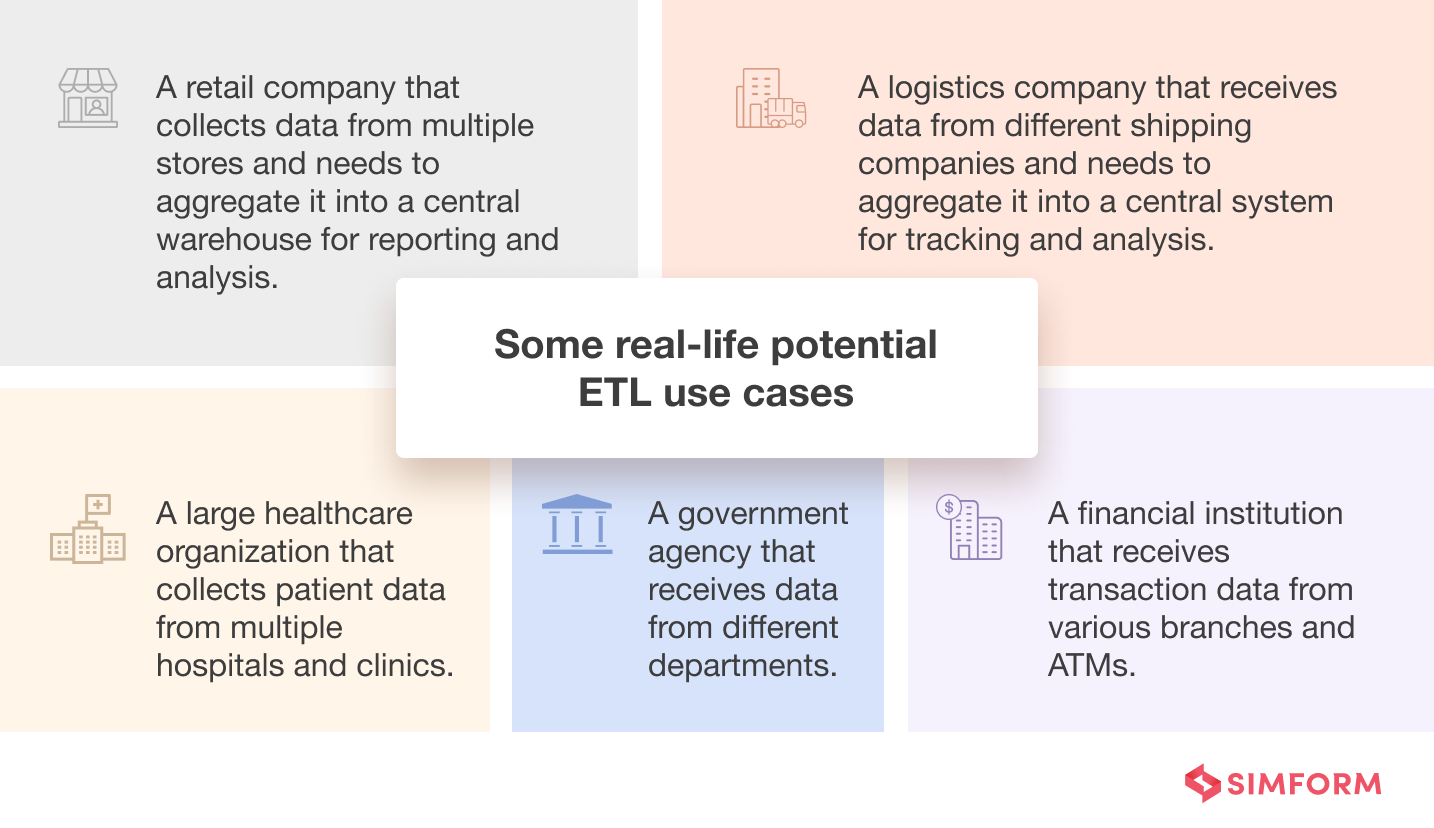As data continues to grow at an unprecedented rate, it’s more important than ever to understand the different data integration methods and how they can impact your organization. ETL and ELT are both commonly used methods for data integration, but they have distinct differences in functionality, performance, and scalability. In this blog post, we will explore the pros and cons of each method and help you determine which amongst ELT vs ELT is the best fit for your organizational needs. Let’s first start with the basics of ETL and ELT.
What is ETL and how does it work?
The acronym ETL stands for Extract, Transform, and Load. It refers to a data integration procedure used to gather information from diverse sources, format it for analysis, and then load it into a data warehouse or any data storage system. ETL is a more traditional approach to data integration and is used to either store legacy data or aggregate data for analysis to drive business decisions.
Although ETL has been used by organizations for decades, it is now evolving as both – data sources and target databases – are moving to the cloud. In a way, ETL and ELT both help the CTOs solve data integration, one of the significant cloud implementation challenges.

How ETL works
To understand the ETL process, let’s dissect what happens during each stage of the procedure.
Extract
During the extraction stage of ETL, raw data is obtained from various sources and moved to a staging area. Data management teams can retrieve data from different types of sources, both structured and unstructured, such as
- Databases
- CRM and ERP systems
- Flat files
- Emails
- Web pages
Understand that this is just a small list of the data sources in which you can use the ETL process.
Transform
During the transformation stage, data management teams sort the data collected at the staging area and convert it into a standard format. This is done to ensure that the target data warehouse receives data in a format that is easy to analyze and use for business decision-making.
During this phase, you might do the following:
- Filtering, cleaning, removing duplicates, splitting, and sorting data
- Performing audits to make sure data is accurate and in line
- Putting the data into tables or tables that are joined together so that they match the schema of the target data warehouse
Load
This final phase involves transferring the converted data from the staging location to the final destination, typically a data warehouse. This often entails:
- Loading all data once
- Loading incremental data updates at regular intervals
- (Less frequently) performing full refreshes to completely delete and reload data from the warehouse.
Most companies that employ ETL do it in an automated, well-defined, continuous, and batch-driven fashion. ETL processes are typically scheduled for times of low source system and data warehouse usage, such as overnight.
What is ELT and how does it work?
ELT, which stands for “Extract, Load, Transform,” is another type of data integration method. This process moves raw data from a source system to a destination resource, like a data warehouse. Even though ELT is similar to ETL, it is a fundamentally different way to prepare data for processing.
Compared to ETL, ELT is a more modern way to connect data. During the load phase, ELT uses the processing power of modern data warehousing solutions, like data lakes, to change the raw data. As a result, there is no need for a separate transformation step that speeds up processing and makes the system more scalable. Traditional ETL methods aren’t as well-suited to handle the growing amount of data organizations create. ELT, on the other hand, can handle large amounts of data easily.
How ELT works
 Extract
Extract
In both ways of managing data, the first step, “extracting,” works the same. Raw data streams are either retrieved as is or based on rules that have already been set.
Load
This step is where ETL and ELT differ. ELT doesn’t send this huge amount of raw data to an interim processing server to be changed. Instead, it sends it all at once to the storage system, where it will eventually live. This reduces the time between data collection and delivery, but it also means that a lot more work must be done before the data can be used.
Transform
The database or data warehouse sorts and normalizes the data, keeping some or all of it on hand and available for custom reporting. The cost of storing huge data collections is higher, but it gives you more chances to mine it for useful business information in almost real-time.
Let's explore the Data ingestion Tools & Best Practices!
Pros and cons of ETL vs ELT
Now let’s understand the pros and cons of ETL vs ELT and then compare them on the basis of the most important parameters.
ETL Pros:
1. Lightning fast analytics
ETL enables businesses to perform quick analytics on structured data, which is one of its key benefits. The process of converting data before loading it into a storage system makes it easy to evaluate and understand. This is particularly helpful for businesses that require immediate insights into their data for decision-making or trend identification.
2. Increased security
ETL also ensures compliance with security protocols such as the EU’s General Data Protection Regulation (GDPR). Unlike ELT, which loads raw data without transformation, ETL transforms the data before loading it, removing sensitive information and ensuring compliance with regulations. This provides an added layer of security to businesses.
3. Reduced storage costs
ETL significantly reduces the storage capacity required, as it only stores pre-structured data. This means that businesses that pay for storage can save money by not having to invest as much in storage solutions.
4. Rich ecosystem
ETL has been around for over two decades, so there is a lot of infrastructure and tools surrounding it. As a result, it’s easier to implement ETL in your organization with the help of numerous resources available.
ETL Cons:
1. Resource-intensive
One of the main disadvantages of ETL is the high initial cost. The cost of ETL can go up to hundreds of thousands of dollars, especially if a business plans to have on-site data storage. Even if the storage is cloud-based, the initial cost is still high due to the need to create a transformation algorithm. This can be a significant setback for businesses with limited budgets.
2. Not very flexible
Another disadvantage of ETL is its lack of flexibility compared to ELT. A large transformation algorithm is required to export and transform data before loading, making it difficult to change or add new data sources. This can be a major drawback for businesses that frequently change their data sources or need to add new ones.
3. Slows down data processing
Working with large amounts of data can also become increasingly difficult with ETL. The transformation stage may become a bottleneck in the system, causing it to process data slower. This can be a major issue for businesses that deal with large amounts of data daily and require real-time insights.
4. Requires a lot of maintenance
When it comes to ETL operations, onsite solutions involving physical servers require more upkeep. Regular maintenance requirement adds to the costs and affects developer productivity. However, automated processes in cloud-based ETL solutions reduce the need for frequent maintenance.
ELT Pros:
1. Faster data loading
One of the main advantages of ELT is that it enables teams to load large amounts of raw data much faster than ETL solutions. This is particularly useful for businesses that deal with big data, as it allows them to quickly analyze and interpret their data.
2. Wide range of analytics options
ELT is also ideal for broad-scope analytics. Because large amounts of raw data are stored, businesses can run both limited and advanced transformations to gain insights into specific areas or historical data. This is not possible with ETL, as it only stores pre-structured data.
3. Easy maintenance
Maintenance is also out of the picture with most ELT systems, as businesses do not have to invest in on-site storage. Many companies offering ELT services also take care of maintenance, freeing your teams to focus on more important tasks.
ELT Cons:
1. Tough implementation
The major disadvantage of ELT is that it can be difficult and expensive to set up. ELT is a relatively new technology, and finding employees or contractors with a high level of expertise can be challenging. Additionally, businesses have to invest a significant amount of resources to set up an ELT pipeline.
2. Expensive to run
Running an ELT system can also be expensive for businesses, as most ELT tools charge for each query depending on the amount of data being transformed. This can be a major issue for small businesses that do not have the resources to run analytics
Now that we know the pros and cons of ETL and ELT, let us understand when you should use ETL and when ELT is the best choice.
Here is a comparison table showing the major differences between ETL and ELT.
ETL vs ELT: Comparison
|
Parameter |
ETL | ELT |
| Speed | Since the data in an ETL warehouse is in a transformed state, data analysts can study the data without delay. | In an ELT warehouse, data is not transformed. Therefore, data analysts must change it as necessary. This strategy increases the time required for data analysis. |
| Storage requirements | Low (because data is stored after transformation) | High (because a lot of raw data is stored) |
| Maturity | Modern ETL has been around for more than 20 years, and its protocols and practices are well-documented. | ELT is a relatively newer way of integrating data, and hence there is less documentation and fewer experts in the industry. |
| Privacy | Teams can reduce the risks associated with personally identifiable information with pre-load transformation. | More stringent privacy protection is needed as data is loaded directly. |
| Maintenance | High maintenance | The burden of maintenance is lessened when there are fewer systems to maintain. |
| Costs | Having separate servers can result in additional financial burdens. | An ELT has a simpler data stack and is less expensive. |
| Flexibility | ETL takes additional planning in advance to guarantee that all necessary data is effectively integrated. Hence there is a limited scope of flexibility in an ETL system. | As transformation is independent of extraction, ELT is more adaptable than ETL for future additions of extracted data. |
| Data Lake Compatibility | No, ETL is not compatible with a data lake. | ELT can be used with data lakes. |
| Data Types Processed | Structured | Structured
Semi-structured Unstructured |
| Where to use | This is the optimal system for relational and structured data. Better for modest to moderate data amounts. |
This is most effective for unstructured and nonrelational data. Ideal for data lakes. Also applicable to homogeneous relational data. Suitable for extremely huge volumes of data. |
`
When should you use ETL?
1. When data requires complex transformation
ETL is a powerful tool for complex data transformations. Its design and architecture are specifically tailored to handle intricate data, making it an ideal solution for such scenarios. ETL supports data transformations like aggregation, normalization, and mapping. When data is smaller in size, ETL can help quickly transform and process it, ensuring that the right information is available at the right time.
2. When data needs to be combined from multiple sources
ETL allows you to extract data from different sources, such as databases, flat files, or even cloud services, and combine it into a single repository. This centralized data store is easier to manage and access and provides a single data version that multiple teams and systems can use. Additionally, ETL tools standardize and cleanse the data before it is loaded into the target system. This helps maintain the quality and accuracy of data.
3. When data needs to be cleansed
ETL tools have built-in data cleansing and validation functions, which can help remove duplicate, inconsistent, and incomplete data from the source. This helps validate the quality and accuracy of data, ensuring that the data is reliable and trustworthy. Furthermore, ETL tools can standardize the data, making it easier to work with and improving its usability.
4. When data requires historical tracking
ETL tools have the ability to store historical data and provide a complete picture of changes over time. This can be useful for tracking trends and making informed decisions, providing valuable insights into the data.
5. When data requires automation
ETL processes can be automated, which eliminates the need for manual intervention. This helps in reducing the chances of errors and improves the speed and efficiency of data processing. Furthermore, automation reduces the time and effort required to manage and process data, freeing up resources for other tasks and allowing teams to focus on other important aspects of their work.
Some potential real-world ETL use cases:
When should you use ELT?
Here are some use cases for ELT
1. When you need to process large amounts of data
When you have a lot of data that needs to be analyzed, ELT is a great choice. With ELT, data collection in one place will be faster than with ETL. Once the data is loaded, ELT uses the powerful processing capabilities of cloud storage to perform the necessary transformations.
2. When there is a quick storage requirement
ELT is perfect for businesses that need to store data quickly for real-time analysis or reporting. With ELT, you can gather all your raw data faster than using ETL.
3. When scalability is your priority
If you are using high-end data processing engines like Hadoop or cloud data warehouses, ELT can take advantage of the native processing power for higher scalability. This is useful for organizations that anticipate growth and want to ensure their data integration processes can handle increased volumes.
4. When you want raw historical data
By keeping all historical data on hand, organizations can mine for hidden patterns and turn them into actionable information. ELT allows access to all the raw data, which can be useful for data scientists and analysts who prefer to work with the original data.
5. When you need a flexible data integration process
If your company has data sources and formats that change frequently, ELT can create a flexible process to cater to these requirements. ELT allows you to make changes to your data pipeline as needed without the need to rebuild the entire process. This can save time and resources while also providing a more agile data integration process.
Some real-life potential ELT use cases:
 Now that you are aware of the potential uses of ELT and ETL, let’s take a look at some ETL and ELT tools.
Now that you are aware of the potential uses of ELT and ETL, let’s take a look at some ETL and ELT tools.
Tools
Let’s take a quick look at the top tools that data engineering teams use for ETL and ELT.
ETL tools
1. Azure Synapse Analytics
Azure Synapse is a powerful analytics service that brings together data warehousing and big data capabilities into one unified platform. It combines enterprise-grade SQL for structured data, Apache Spark for big data processing, Data Explorer for log and time series analytics, and built-in pipelines for ETL/ELT and data integration.
What makes Synapse stand out is its ability to let users query data on their own terms, whether using on-demand serverless resources or dedicated compute. It seamlessly connects with services like Power BI, Azure ML, and Cosmos DB, making it easier to turn raw data into actionable insights.
Additionally, Synapse includes advanced security features such as column-level security, dynamic data masking, and always-on encryption—helping teams analyze data at massive scale while keeping it protected.
2. Azure Data Factory
Microsoft’s Azure Data Factory is a cloud-based ETL tool used to build workflows that efficiently move and transform large amounts of data.
It consists of a lot of linked systems. Together, these solutions enable engineers to plan, manage, and keep an eye on data pipelines to transform data.
The breadth of Data Factory’s connectors—from MySQL to AWS, MongoDB, Salesforce, and SAP—is what makes it so powerful. In Azure Data Factory, the users can communicate using either a command-line interface or a no-code graphical user interface.
3. Azure Databricks
Azure Databricks is a unified analytics platform optimized for the Azure cloud. It simplifies building, deploying, and managing large-scale data, analytics, and AI solutions, all on a fully managed architecture.
Designed for collaboration, Databricks lets teams of data engineers, data scientists, and analysts work together through interactive notebooks and a shared workspace. It supports everything from batch and streaming ETL to machine learning and BI use cases, all within an open, governed lakehouse architecture.
The platform integrates natively with Azure services like Data Lake Storage, Data Factory, Synapse Analytics, and Power BI, allowing users to eliminate data silos and unify all their data workloads from ingestion to insight—on a single, scalable platform.
ELT tools
1. Airbyte
Airbyte is an open-source ELT tool that helps data teams extract and load data from various sources into destination repositories quickly and easily. It features 140+ pre-built connectors, the ability to schedule updates, and real-time monitoring and error logging. Airbyte integrates with modern technologies such as Kubernetes, Airflow, and dbt, and enables custom transformations.
2. Fivetran
Fivetran is an ELT tool that offers a complete data integration package that includes:
- Incorporating data transformations
- Providing built-in version control
- Documentation
- Testing
- Monitoring and error detection
- Rectifying corrupt processes
Additionally, it enables database replication and advanced analytics for various departments such as marketing, sales, finance, and customer success.
At Simform, our team of data engineering experts has extensive experience in implementing ELT and ETL tools to help organizations extract, transform and load data from various sources into their destination repositories. Our deep knowledge of these tools, combined with our prowess in data engineering, enables us to provide customized solutions to meet the unique needs of each business.
For successful cloud implementation, you need to take a holistic view. In addition to data integration tools, you need to select an appropriate cloud deployment model. Our team can also assist with the selection of the best cloud deployment model according to your requirements.
Simform can help you choose the right data integration approach
The choice between ETL and ELT ultimately depends on the unique needs and goals of your business. Both methods have their advantages and disadvantages. So the best approach for your organization will depend on factors such as the size and complexity of your data, the tools and infrastructure you have in place, and the desired outcome of your data integration process.
At Simform, our data engineering consultants can help you navigate these options and determine the best approach for your organization. With our deep knowledge of both ETL and ELT, as well as our experience working with a wide range of businesses across industries, we can help you make the right choice for your specific needs and goals. If your organization works with on-site data storage systems, our team can also help you devise a cloud migration strategy. Just contact our data engineering experts, and we will be happy to answer all your queries.
